This video shows the Chelyabinsk meteor explosion and plume, as modeled by a NASA satellite. (Credit: NASA/Goddard Space Flight Center)
Learn More About Berkeley Lab’s X-ray Work with NASA (click on an image below)
Overview
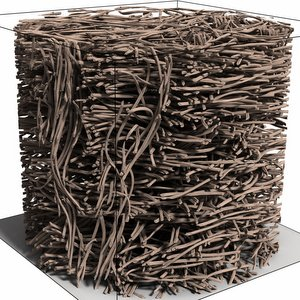
Heat Shields
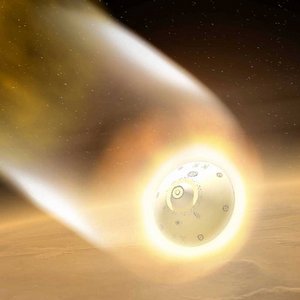
Parachutes
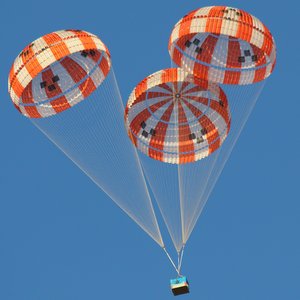
Four years ago, a brilliant fireball streaked across the dawn sky over Russia, then fractured with the force of about 500,000 tons of TNT. The shock wave blew out windows and damaged thousands of buildings across several cities in Russia’s Chelyabinsk Oblast region, injuring about 1,500 people.
The school bus–sized meteoroid that caused this destruction was estimated to weigh about 11,000 tons and was traveling approximately 60 times the speed of sound. Fortunately, it broke apart at a height of about 19 miles, and wasn’t above a city. An explosion of this magnitude would have caused far greater damage if it had occurred at lower altitudes over a densely populated area.
NASA’s Planetary Defense Coordination Office is charged with monitoring the paths of asteroids and other objects with orbits that could send them on a crash course with Earth, and planning for response to an actual impact threat.
Under this office, NASA’s Asteroid Threat Assessment Project has been established to develop predictive tools, including physics-based computer simulations, to assess the impact threat posed by so-called “near-Earth asteroids” and a subclass of these objects deemed “potentially hazardous asteroids.”
X-ray studies of meteorite samples planned at Berkeley Lab’s Advanced Light Source (ALS) will aid this effort by providing new insights about the microscopic makeup of an asteroid’s constituent material, and breakup of meteoroids in the atmosphere.
Harold Barnard, a scientist at Berkeley Lab’s ALS, has developed a specialized test chamber for X-ray studies of meteorite samples that simulates the extreme compressive forces asteroids experience when traveling through Earth’s atmosphere.
The cylindrical chamber has grips that serve like a vice to exert pressure on meteorite samples, and X-ray imaging can study how this compression, in combination with heat and pressure, affects their microscopic structure.
“We want to understand the fracture mechanics of meteors,” he said, which will serve to inform and test computer models of asteroids as they fall from the sky, which in turn are used to predict the strength of the explosion when they break up.
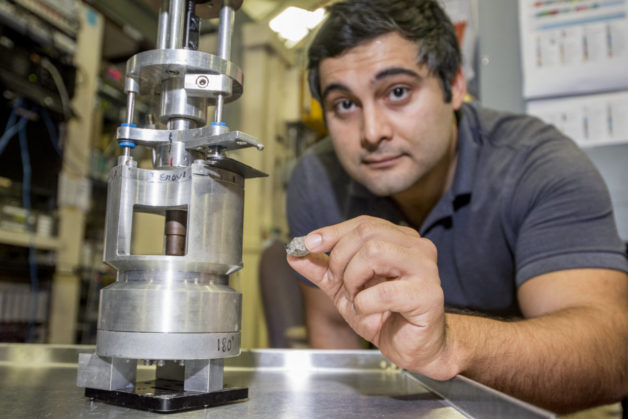
Harold Barnard, a scientist at Berkeley Lab’s Advanced Light Source, holds a small meteorite sample. At left is an experimental chamber that is designed to compress and heat the sample to simulate atmospheric entry conditions. (Credit: Marilyn Chung/Berkeley Lab)
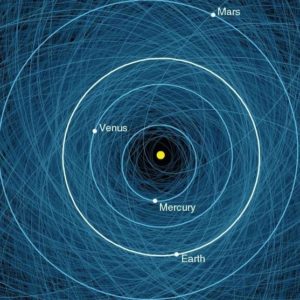
This image shows the orbits of more than 1,000 asteroids that measure more than 150 yards across and pass within 4.7 million miles of Earth, up to about 20 times farther than the moon is from the Earth. (Credit: NASA/JPL-Caltech)
Francesco Panerai, a scientist with AMA Inc. working at NASA Ames Research Center (NASA ARC) in Moffett Field, Calif., and who will direct the meteorite studies at the ALS, said the experiments aim to help us understand how asteroids fracture and break up.
“It is very complex science, but it has a lot of common features with (spacecraft) entry systems,” Panerai said. “We will apply the tools we have to model spacecraft to asteroids.”
He added, “One of the tricky parts is understanding how meteorites fracture at the microscopic level, and how the material will eventually burst in the atmosphere,” as meteorites have a complex microscopic structure compared to ordinary rocks and behave in different ways under stress. “We are trying to see if we can image the cracks and the propagation of fractures.”
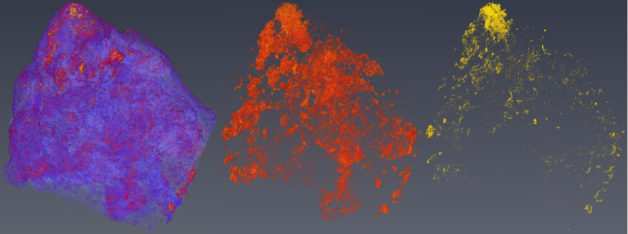
The makeup of a meteorite: This series of X-ray-based images shows (from left) a 3-D volume rendering of a meteorite sample, medium-density metallic alloys and oxides in the sample (center), and high-density metals (right). (Credit: NASA, Berkeley Lab)
Mapping this microstructure to a large asteroid could help to predict the height and strength of the explosion, for example, or the likely impacted area of an impending meteorite strike after midair breakup.
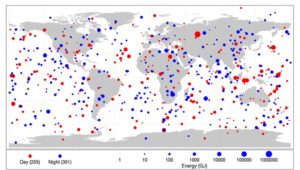
This map displays satellite observations of brilliant meteors, called bolides, from 1994-2013. There were an average of 29 events per year sighted during this period. (Credit: NASA)
The ALS study will provide detailed 3-D views of the internal structure of the sample under stress by aggregating a sequence of X-ray images taken at different stages of heating and tension, and from different angles.
Dula Parkinson, a research scientist at Berkeley Lab who works on the NASA-related projects, said the same sample cell can stretch or compress a range of different materials in other types of experiments, too: “It can work for anything you want to crush or pull on,” he said. “When someone has an application that’s challenging, it really pushes you to develop something new.”
Learn more about the research partnership between NASA and Berkeley Lab in these articles:
- When Rocket Science Meets X-ray Science: Berkeley Lab and NASA collaborate in X-ray experiments to ensure safety, reliability of spacecraft systems.
- The Heat is On: X-rays reveal how simulated atmospheric entry conditions impact spacecraft shielding.
- A New Paradigm in Parachute Design: X-ray studies showing the microscopic structure of spacecraft parachute fabrics can fill in key details about how they perform under extreme conditions.
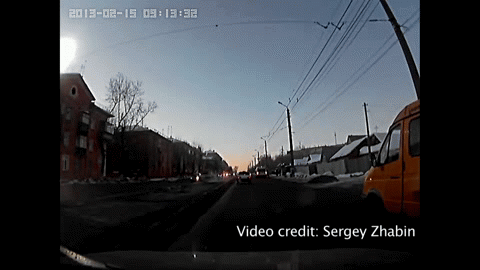
A meteorite explodes in the air above Chelyabinsk, Russia, in this video clip. (Credit: Sergey Zhabin, NASA)
The Advanced Light Source is a DOE Office of Science User Facility.
# # #
Lawrence Berkeley National Laboratory addresses the world’s most urgent scientific challenges by advancing sustainable energy, protecting human health, creating new materials, and revealing the origin and fate of the universe. Founded in 1931, Berkeley Lab’s scientific expertise has been recognized with 13 Nobel Prizes. The University of California manages Berkeley Lab for the U.S. Department of Energy’s Office of Science. For more, visit www.lbl.gov.
DOE’s Office of Science is the single largest supporter of basic research in the physical sciences in the United States, and is working to address some of the most pressing challenges of our time. For more information, please visit science.energy.gov.
